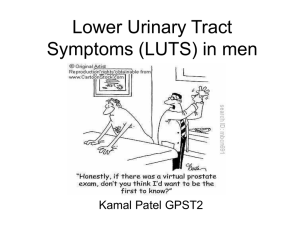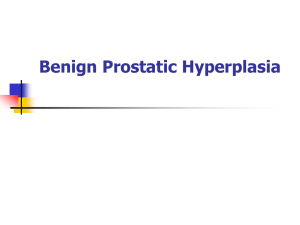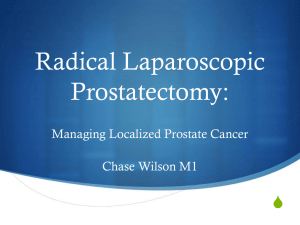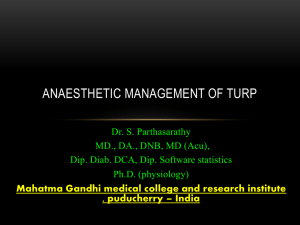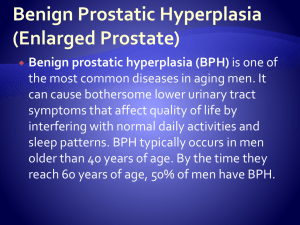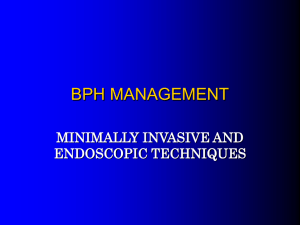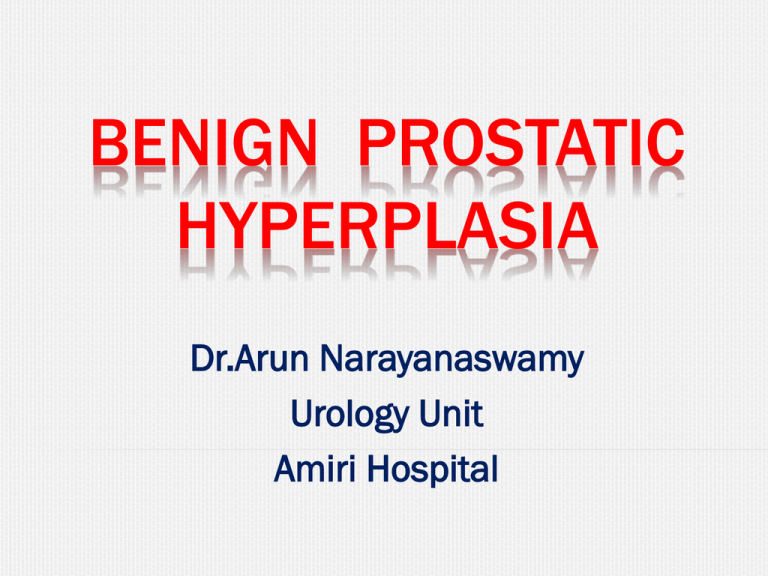
BENIGN PROSTATIC
HYPERPLASIA
Dr.Arun Narayanaswamy
Urology Unit
Amiri Hospital
OUTLINE
BPH
Anatomy of Prostate
Aetiology
Pathophysiology
Incidence
Clinical presentation
Investigations
Management
Catheterisation
Indications
Catheter types
Technique
Complications
Anatomy of Prostate gland
Walnut-sized. Part of male reproductive system
Location
Anterior to rectum,
Just distal to bladder,
Encircling the neck of
bladder and urethra
Normal weight – 20gm
Anatomy of Prostate gland
Prostatic parenchyma divided into 4 Zones.
Biologically and anatomical distinct.
Functions of Prostate gland
Secretes alkaline fluid–30% of seminal volume
Actions - Lubrication and nutrition for sperm,
Liquefaction of the seminal plug,
Neutralizes acidic vaginal environment
Prevents retrograde ejaculation (ejaculation
resulting in semen being forced backwards into
the bladder) by closing the bladder neck during
sexual climax.
What is BPH ?
BPH is part of the natural aging process,
like getting gray hair or wearing glasses
Characterized by hyperplasia of
prostatic stromal and epithelial cells.
Occurs in the Transitional zone.
Results in formation of nodules in the
periurethral region of the prostate.
What is BPH ?
Urethra
Peripheral Zone
Transition zone
Aetiology of Hyperplasia
DHT-mediated hyperplasia aided by estrogens
In aging men, estradiol levels increase.
Mechanism of Obstruction
Mechanical Component - When sufficiently
large, the nodules compress the urethral canal
Mechanism of Obstruction
Dynamic Component - Large numbers of
alpha-1-adrenergic receptors present in the
smooth muscle of the stroma and capsule
of the prostate, bladder neck.
Stimulation causes ↑ in smooth-muscle tone
Pathology of BPH
Gross - Circumscribed grey white nodules
Histology
Epithelial - Glandular proliferation or dilation
Stromal - Fibrous or Muscular proliferation
Mostly common - Fibroadenomyomatous pattern
BPH - Bladder Effects
Bladder wall - contractile force leads to:
Hypertrophy or Trabeculation, and Irritability.
Bladder may gradually weaken
Increased residual urine volume
Acute or chronic urinary retention.
Biopsy
- smooth-muscle fibers / in collagen
- Decrease compliance, Impair contraction
Prevalence of BPH
•25% - 40-49 years
•50% - 70 & older
•90% at 85 years
Source: J Urol 1984;132:474
• Only 50% develop clinical symptoms.
• Severity of symptoms not related to size.
• Second most common surgery after
cataract extraction in men > 65 years.
Common Terms
• LUTS
Lower-urinary-tract symptoms
• BPE
Benign prostatic enlargement
(macroscopic)
• BPH
Benign prostatic hyperplasia
(microscopic/histologic)
• BOO
Bladder-outlet obstruction
Symptoms
Obstructive Symptoms
(Voiding)
Elective
- Weak stream
- Straining to void
- Hesitancy
- Intermittency
- Terminal dribbling
- Incomplete emptying
Irritative Symptoms
(Storage)
Emergency
- Acute urinary
retention
- Chronic Retention
with overflow
- Dysuria
- Frequency
- Nocturia
- Urgency
- Incontinence
- Nocturnal enuresis
Symptom Assessment
International Prostate Symptom Score (IPSS)
/ AUA Score
Based on a survey & questionnaire developed
by the American Urological Association (AUA).
7 questions about the severity of symptoms.
Total score: Mild
0- 7
Moderate 8 - 19
Severe
20 - 35
Sexual history
Studies have identified LUTS as an independent
risk factor for erectile / ejaculatory dysfunction.
Physical Examination
Suprapubic area - Bladder distension
Neurological examination Decreased anal sphincter tone
Absent bulbocavernosus reflex
Palpate the scrotum: epididymo orchitis
Signs of CRF, Pallor
Rectal Examination
Left lateral position
Index finger of the dominant hand.
Palpate circumferentially
- windshield wiper movement
Rectal Examination
Prostate size and contour, Median sulci
Consistency
Nodules, Hardness, Asymmetry suggestive of malignancy.
Pain - Prostatitis,
Fluctuance - Prostate abscess
Rectal mucosa
Complications of BPH
Urinary retention
Recurrent UTIs
Gross hematuria
Bladder calculi
Bladder Diverticuli
Renal failure or uremia
Differential Diagnosis
Urethral Strictures
Bladder Stones
Neurogenic Bladder
Prostatitis
Bladder Tumours
Radiation Cystitis
Interstitial Cystitis
Investigations
Basic Iab:
CBC / S.Creat
Urine routine / culture
PSA(prostate specific antigen)
Xray KUB :calculi
Ultrasound
Uroflowmetry
Flexible Cystoscopy
Prostate Specific Antigen
Secreted by Prostatic cells.
Normal <4ng/dl
Marker for Carcinoma Prostate – Elevated.
BPH does not lead to prostate cancer.
However men at risk for BPH are also at risk
for prostate cancer and so should be screened.
Not disease specific - Also in BPH,
Prostatitis,DRE,Catheterization
High PSA →Trans rectal US and Biopsy
Ultrasonography
Prostate – Size (>20cm3:abnormal), Nature
Bladder – Wall thickness, Diverticuli, Calculi
Kidneys - Hydronephrosis
Post micturition residual volume(>50-100ml)
Uroflowmetry
Simple noninvasive test to document voiding
Peak Flow rate (>15ml/s is normal)
Voiding time, Voiding pattern
Volume of voided urine – atleast 150ml
Uroflowmetry
Cystometry - Pressure flow
Invasive – Urethral / Rectal catheterization.
Indication - To distinguish bladder contractility
(detrusor underactivity) from outlet obstruction.
BOO -Low urine flow rates accompanied by
High intravesical voiding pressure (>60 cm water)
Cystoscopy
Flexible cystoscopy can be easily performed
in an office-based setting using topical gelintraurethral anesthesia without sedation.
Indicated when Suspicion of
Urethral stricture - h/o STD,
prolonged catheterization,
or trauma
Detrusor hypocontractility DM
Treatment Options
Watchful waiting
Medical management
Surgical approaches
- Endoscopic surgery
- Minimal invasive procedures
- Open surgery
Watchful Waiting
For mild symptoms.
Follow up 1 to 2 times yearly
Suggestions that help reduce symptoms
- Avoid caffeine and alcohol
- Alteration of timing, volume of fluid intake
Medical Management
Benefits
Convenient
No loss of work time
Minimal risk
Types –
Disadvantages
Drug Interactions
Must be taken every day
Does not fix problem
Side Effects
Cost
Alpha Adrenergic Blockers
5 alpha reductase inhibitors
Alpha 1 Adrenergic
Receptors
Alpha Blockers - Rationale
BPH predominantly stromal (Smooth muscle )
proliferative process - Dynamic Obstruction
Mediated by the alpha1A-adrenergic receptors.
Density of receptors changes with
prostate size & age.
Alpha-adrenergic receptor-blocking agents
Relax the smooth muscle
Decrease outflow resistance.
Alpha Blockers - Agents
Nonselective
- Phenoxybenzamine
Short-acting selective a1-blocker
- Prazosin,
Long-acting selective a1-blockers
- Terazosin, Doxazosin
Long-acting selective a1A-subtype
- Tamsulosin
- Alfuzosin
- Silodosin
Alpha Blockers - Advantages
Quick action
Improves urinary flow 4- to 6-point improvement is expected
in IPSS/AUA scores
No adverse effect upon sexual drive
No effect on PSA
Alpha Blockers - Disadvantages
No effect on Prostate volume
No reduction in risk of acute urinary
retention or BPH-related surgery.
Lowers blood pressure
Fatigue, nasal congestion, headache
Retrograde Ejaculation
Intraoperative floppy iris syndrome (IFIS) Miosis, iris billowing, and prolapse in
patients undergoing cataract surgery
5 Alpha Reductase - Rationale
Prostatic growth depends on androgenic
stimulation by DHT.
5a-reductase mediates conversion.
Agents that block 5a-reductase inhibit
growth and therefore help in BPH
Types - type I and type II
Type II predominates in the prostate and
other genital tissues.
5 Alpha Reductase - Agents
Finasteride Selective inhibitor of type II 5a-reductase
Dutasteride Newer agent. Has affinity for both Types
Similar efficacy.
Both agents actively reduce serum DHT
levels by more than 80%,
Change in Prostate Volume
% Change in prostate
volume from baseline
30
20
Dutasteride
Finasteride
a-blockers
10
0
-10
-20
-30
McConnell et al. (1998); McConnell et al. (2003); Roehrborn et al. (2002); Lowe et al. (2003)
5 Alpha Reductase - Advantages
Reduce prostate volume by 20%
Improve symptoms in a third of men and
increase peak flow by around 2ml/s
55% reduction in incidence of urinary retention,
and likelihood of surgery for BPH.
Longer acting
Less side effects than alpha blockers
Can reverse male pattern balding
5 Alpha Reductase - Advantages
Reduce bleeding during surgery.
5 Alpha Reductase - Disadvantages
Slow to act - Takes up to six months to work
Not effective for mildly enlarged prostates
Can affect sexual function
Can cause breast swelling
Transmitted in semen and can cause birth
defects. Users should have protected sex.
Caution in liver function abnormalities
Lowers serum PSA level by 50% .
Combination Therapy
• Activates Two Distinct and Complementary
Mechanisms of Action.
Alpha blockers
Relaxes prostatic
and bladder-neck
smooth muscle
through sympathetic
activity blockade
Rapidly relieve
symptoms
5-Alpha reductase inhibitors
Reduces prostate
enlargement through
hormonal mechanisms
Arrest disease
progression
Dutasteride+Tamsulosin / Finasteride+Tamsulosin.
Decrease in Symptom Score
Increase in Peak Flow
Combination Therapy
Patients with prostates >30 gm.
Superior to monotherapy over long term.
Risk of acute urinary retention decreased by
79% - Combination therapy
31% - a-blocker alone
67% - 5a-reductase inhibitor alone.
Alpha blocker may be withdrawn after 6 months
Phosphodiesterase 5 Inhibitors
Treatment of associated ED
Nitric oxide known to mediate smooth muscle
relaxation in the lower urinary tract.
Improvements in Urinary symptoms reported
Smallest necessary dose.
Should not be taken within 4 hours of any
alpha-blocker
Anticholinergics
Treatment of Frequency / Urgency.
Relaxes Detrusor muscle.
Historically, discouraged because of concerns
of inducing urinary retention.
Recommend only in patients who do not have
an elevated PVR.
Not to be used when PVR is greater than
250-300 mL
Phytotherapy
Considered emerging therapy
Saw palmetto (American dwarf palm) Leaf
South African star grass (Hypoxis rooperi) roots
African plum tree (Pygeum africanum) bark
Stinging nettle (Urtica dioica) roots
Rye (Secale cereale) pollen
Pumpkin (Cucurbita pepo) seeds
Active components - Phytosterols, Fatty acids,
Lectins, Flavonoids, Plant oils, & Polysaccharides
Phytotherapy
Modes of action:
Antiandrogenic, Antiestrogenic effect
Inhibition of 5-alpha-reductase
Blockage of alpha receptors
Antiedematous, Anti-inflammatory effect
Inhibition of prostatic cell proliferation
Interference with prostaglandin metabolism
Protection and strengthening of detrusor
Algorithm for Medical Therapy
Patient
IPSS ≤7
IPSS >7
No or
little
bother
Prostate small
No Treatment
Prostate large
Preventive therapy
5a-Reductase Inhibitor
Moderate to
severe
bother
Prostate small
aAdrenergic
Blocker
Prostate large
5a-Reductase
Inhibitor
Combination Rx
Follow Up
Diet
Diet low in fat and red meat and high in
protein and vegetables may reduce the risk
of symptomatic BPH.
Long-term Monitoring
At least biannually evaluation to discuss the
efficacy of medication and potential dose
adjustment.
Atleast annual DRE and PSA screening.
Indication for Surgery
Dissatisfied with medical management
Unwilling to take daily medication
Financial constraints
Complicated BPH
Renal dysfunction(obstructive uropathy)
Recurrent attacks of acute retention of urine
Recurrent UTI, Haematuria
Bladder Calculi
Surgical Options
Endoscopic Surgery
TURP
Bladder neck incision
Laser Prostatectomy
Minimally invasive
TUNA,TUMT, Balloon dilatation, Stents
Open prostatectomy
Trans Urethral Resection
of Prostate (TURP)
Gold Standard of care for BPH
Endoscopic electrocautery “knife” used.
Obstructive symptom improved - 80~90%
Irritative symptom improved - 30%
Low mortality rate - 0.2%
Morbidity - 18%
TURP - Technique
Regional /General anesthesia
Working sheath placed in
the urethra through which a
hand-held device with an
attached wire loop is placed.
TURP - Technique
High-energy electrical cutting current is run
through the loop and used to shave away
prostatic tissue.
The entire device is usually attached to a video
camera to provide vision for the surgeon.
TURP - Technique
TURP
Post-op:
• Three way catheter
• Continuous bladder
irrigation with
N.Saline until urine
clear of clots
TURP
Disadvantages
Benefits
n
Widely available
n
Effective
n
Long lasting
n
Side effects and
complications
n
1-4 days hospital stay
n
1-3 days catheter
n
4-6 week recovery
TURP - Complications
Immediate
Bleeding and clot retention
Capsular perforation / fluid extravasation
Sepsis
TURP syndrome
TURP Syndrome
Absorbtion of Irrigation fluid (glycine)
into the open prostatic vein
Fluid overload - Pulmonary oedema,
Cerebral oedema
Haemodilution - Hyponatraemia,
Haemolysis
Treatment - Stop Surgery, IV frusemide,
Hypertonic saline
TURP - Complications
Delayed
Urethral stricture
Bladder neck contracture
Retrograde ejaculation(90%)
Impotence (5-10%)
Incontinence (0.1%)
Trans Urethral Incision
of Prostate (TUIP)
Indications
Small prostates
Cannot tolerate TURP (medical conditions)
Advantage over TURP
Less bleeding
Less fluid absorption
Lower incidence of retrograde ejaculation
Lower incidence of impotence.
Laser Prostatectomy
Mechanism
Heats tissue - Causing coagulative necrosis,
and subsequent tissue contraction
Evaporate - Melts away, prostate tissue.
More effective.
Knifelike fashion - To directly cut away
prostate tissue
Laser Prostatectomy
Types
Transurethral laser-induced prostatectomy (TULIP)
Visual laser ablation of the prostate (VLAP)
Interstitial laser coagulation of the prostate (ILC)
Holmium:YAG laser resection of prostate (HoLRP)
Holmium:YAG laser enucleation of prostate (HoLEP)
Photoselective Vaporisation of Prostate Green light prostatectomy (PVP)
Green Light Prostatectomy (PVP)
n
Uses a very high powered green laser and a thin,
flexible fiber
n
Fiber is inserted into
the urethra through a
cystoscope
Green Light Prostatectomy (PVP)
n Quickly and precisely vaporizes and removes the
enlarged prostate tissue
n The green laser energy is hemostatic, so there is
almost no bleeding
Green Light Prostatectomy (PVP)
Enlarged Prostate
n
n
Urethra is obstructed
Urine flow blocked
After GreenLight PVP
n
n
Urethra is open
Normal urine flow is
restored
Laser Prostatectomy
Advantages
Catheter time less - 24 hours.
Reduced hospital stay 59 vs 86 hours
Equal results.
Less bleeding. 23.3 vs 2.1 ml per minute. Useful
inpatients who require anticoagulation.
TUR syndrome is not seen
incidence of impotence / retrograde ejaculation
Laser Prostatectomy –
Disadvantages
Longer operating time - 74 vs 57 min.
No tissue for biopsy - Vaporization technique.
Dysuria / Urgency - Healing from laser
treatment does not occur until after a period
of weeks when dead cells slough.
Minimally Invasive Therapy
Developed during the last decade to
challenge TURP
Aim – Minimise anesthesia, blood loss, fluid
absorbption, risk and hospital stay.
Mechanism Heat destruction causing necrosis.
Mechanical approaches.
Efficacy – Between medical therapy & TURP.
Minimally Invasive Therapy
Transurethral microwave thermotherapy (TUMT):
Heat delivered to prostate via urethral catheter.
Transurethral needle ablation of the prostate
(TUNA): High-frequency radio waves delivered
using a transurethral device with needles.
Cryotherapy
High-intensity focused ultrasound(HIFU)
Delivered rectally or extracorporeally
Minimally Invasive Therapy
Transurethral balloon dilatation of prostate
Intraprostatic stent
Flexible devices that can expand when put in
place to improve the flow of urine.
Complications - Encrustation, Pain, Incontinence,
Overgrowth of tissue through the stent (making
removal difficult).
Transurethral ethanol ablation of the prostate
Botulinum toxin-A injection of the prostate
Open Prostatectomy
Indication Large prostate(>100gm)
Co existing bladder pathology : calculi, diverticula.
Lithotomy position not possible : eg:Hip joint disease
Technique Lower abdominal incision.
Retropubic/Transvesical
The inner core of the prostate (adenoma), which
represents the transition zone, is shelled out,
leaving the peripheral zone behind.
Urinary Catheterisation
Facilitates direct drainage of urinary bladder.
Indications
Diagnostic
Collection of uncontaminated urine
specimen
Monitoring of urine output
Imaging of the urinary tract
Indications
Therapeutic
Acute urinary retention
Chronic retention causing hydronephrosis
Continuous bladder irrigation (hematuria)
Intermittent catherisation Neurogenic bladder
Hygienic care of bedridden patients
Short-term drainage (eg, post surgery)
Urinary Retention - Acute
Features
Painful
Normal renal function
Precipitating event
- UTI
- Fluid overload
- Constipation
- Medication
Causes
BPH
Urethral Stricture
Urethral Stone
Trauma
Neurogenic
Psychogenic
Post op
Urinary Retention - Chronic
Features
Painless
Impaired renal function
Large residual volume
Causes
BPH
Impaired Detrusor
contractility
Contraindications for
Urethral Cath
Traumatic injury to the lower urinary tract male patients with pelvic or straddle-type
injury.
Signs for injury - Blood at the meatus, Perineal
hematoma, High-riding or boggy prostate.
Retrograde urethrogram should be performed
prior to catheterisation
Catheterisation by urologist.
Urinary Catheterisation
Urethral Catheter
Urinary Catheterisation
Suprapubic Catheter
Equipment
Povidone-iodine
Sterile cotton balls
Water-soluble lubrication gel
Sterile drapes, Sterile gloves
Urethral catheter
Prefilled 10-mL syringe
Urobag for collection
Catheter Types
Foleys
- 2 way Catheter
- 3 way irrigation catheter
(gross hematuria)
Tip
- Straight tip
- Coudé tip:
(Prostatic Obstruction)
Catheter Sizes
Adults 14F 16F 18F
Hematuria catheters 20F 22F 24F
Children – Smaller
Infants feeding tubes
Colour coded
Catheter Material
Latex (silicone-coated)
Pure silicone
Silver alloy
Antibiotic-impregnated
Catheterisation Technique
Prophylactic antibiotics
Males - Supine
Female - Frogleg position, with knees flexed.
Sterile gloves
Clean with antiseptic solution
Sterile drapes.
Instillation of Jelly
Hold penis firmly and extended
Place tip of syringe / applicator in the meatus
Apply gentle but continuous pressure
and apply a generous amount of jelly.
Occlude the urethral tip and for a couple of
minutes to allow the anesthetic to take effect.
Catheterisation Technique
Males - Hold the penis at approximately 90°
and stretch it upward to straighten out penile
urethra, slowly and gently introduce catheter.
Females – Separate labia and visualize meatus.
Catheterisation Technique
Advance the catheter until the proximal Yshaped ports are at the meatus.
Wait for urine to drain from larger port to ensure
that distal end of the catheter is in the Bladder.
Catheterisation Technique
After urine return, inflate the balloon with
distilled water through the cuff inflation port.
Maximal recommended volume
for balloon inflation can be found
on inflation valve (10-30 mL).
Lubricant jelly–filled distal
catheter openings may delay urine return. If
no spontaneous return of urine occurs, try
attaching a 60-mL syringe to aspirate urine.
Catheterisation Technique
Gently withdraw the catheter until
resistance is met.
Secure catheter to thigh with a wide tape.
Uncircumcised patient – Reduce foreskin.
Failure to do so can cause paraphimosis.
Catheter Removal
Use a syringe to empty the balloon, and then
apply gentle traction.
Complications
Infections - Urethritis, Cystitis,
Pyelonephritis, and Transient bacteremia
Bleeding
Creation of false passages
Inflation of the balloon inside the
urethra resulting urethral tear.
Urethral strictures
Encrustation
Fragmentation
THANK YOU


